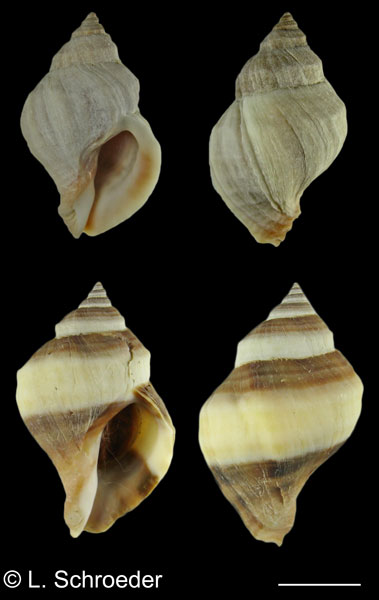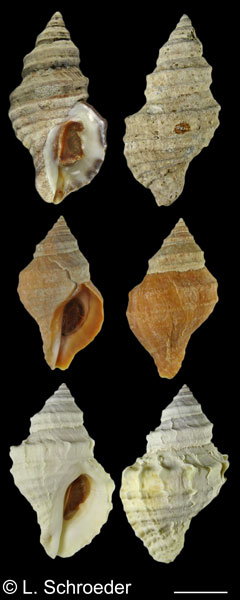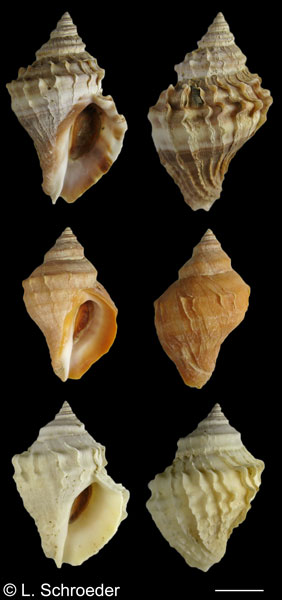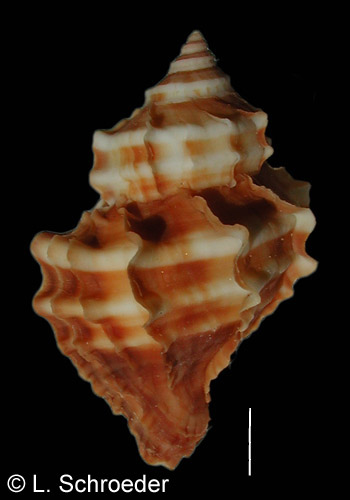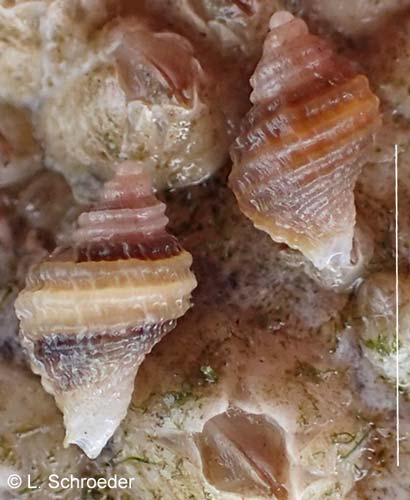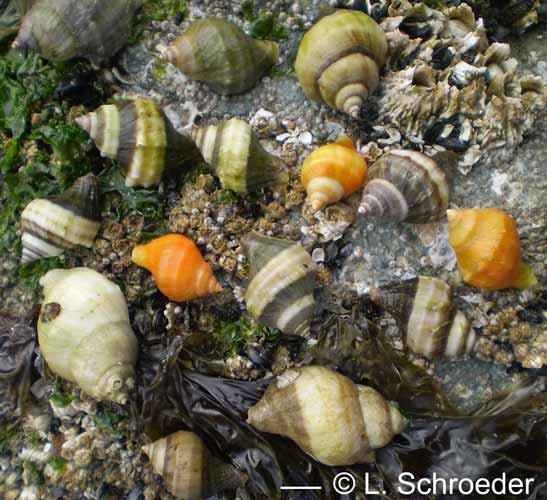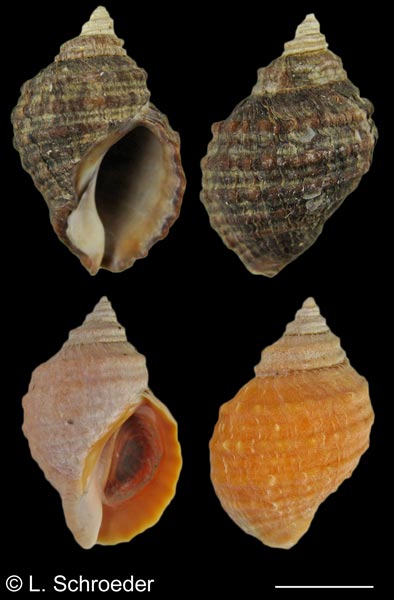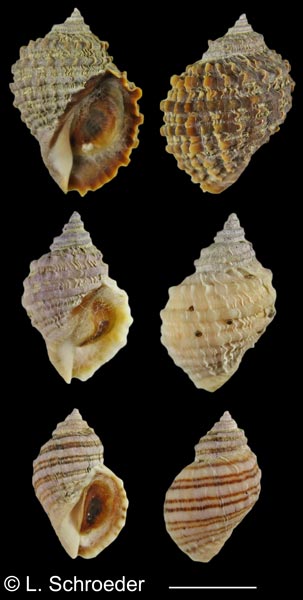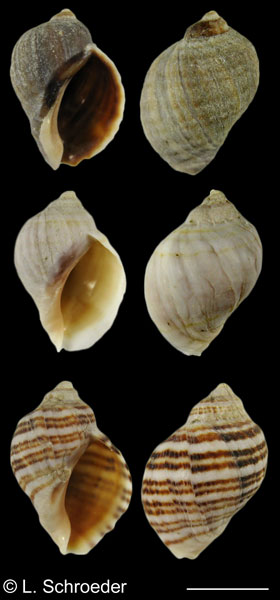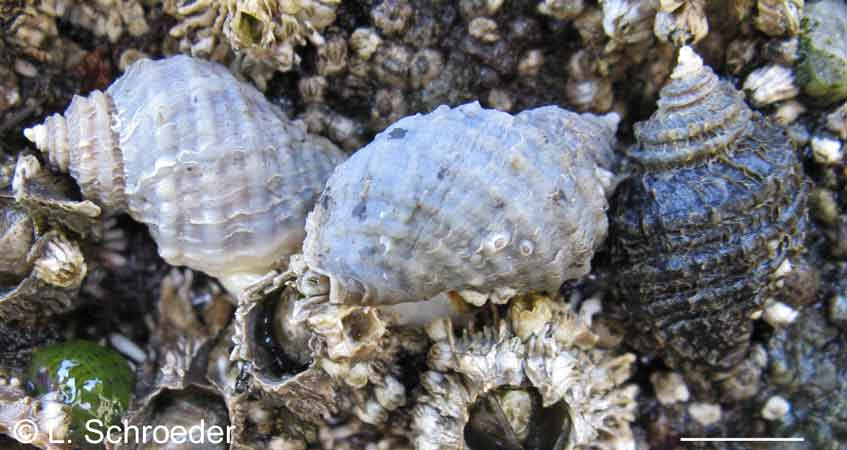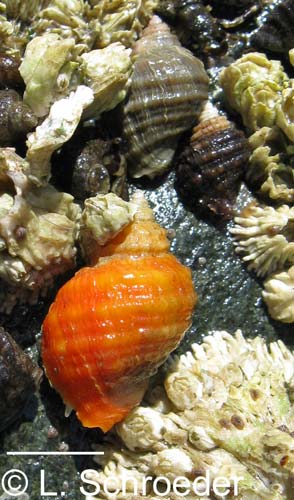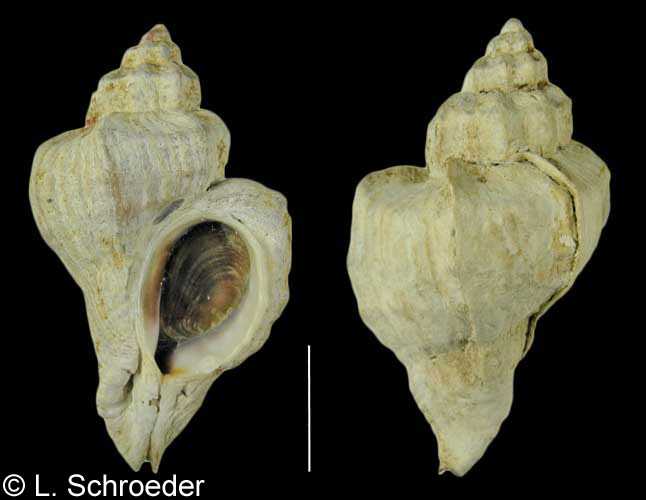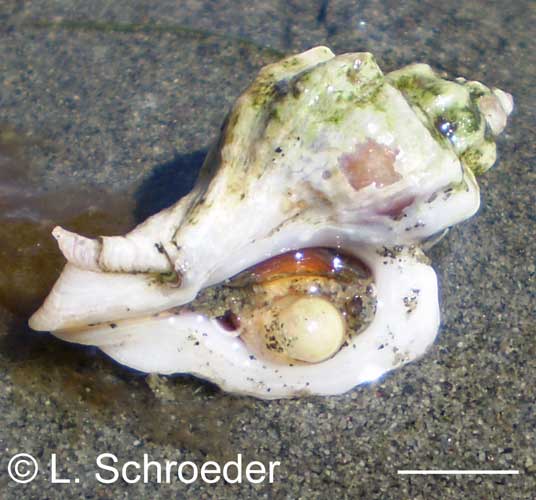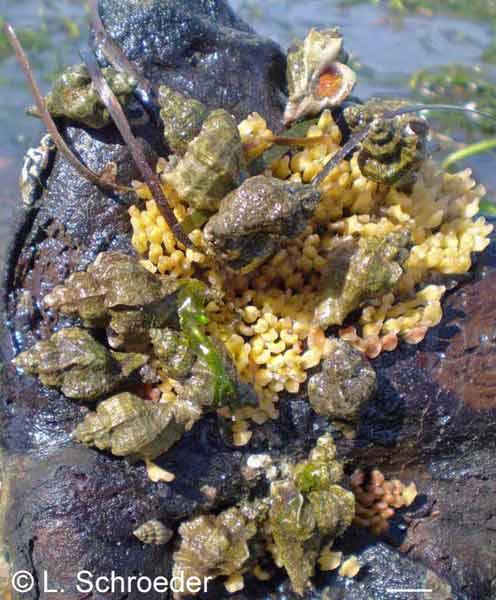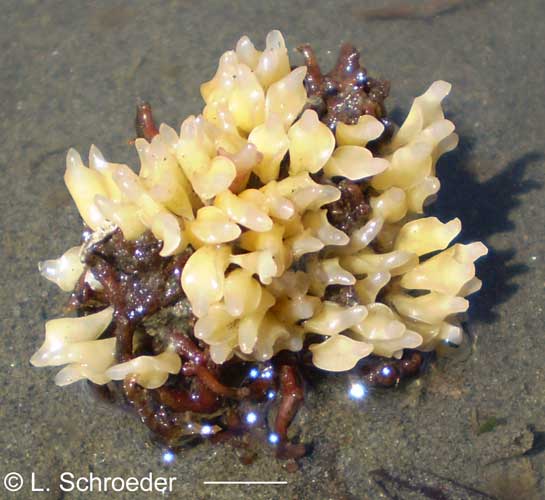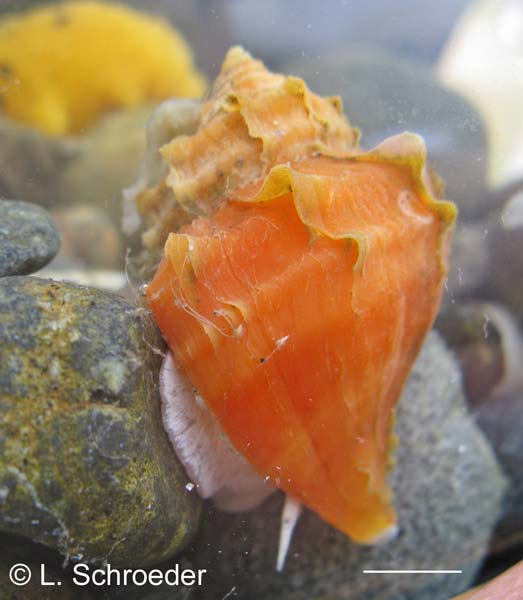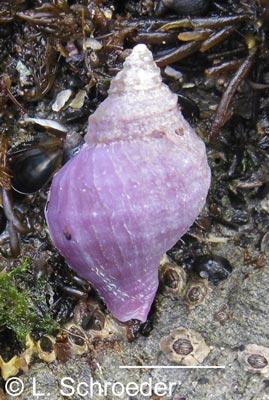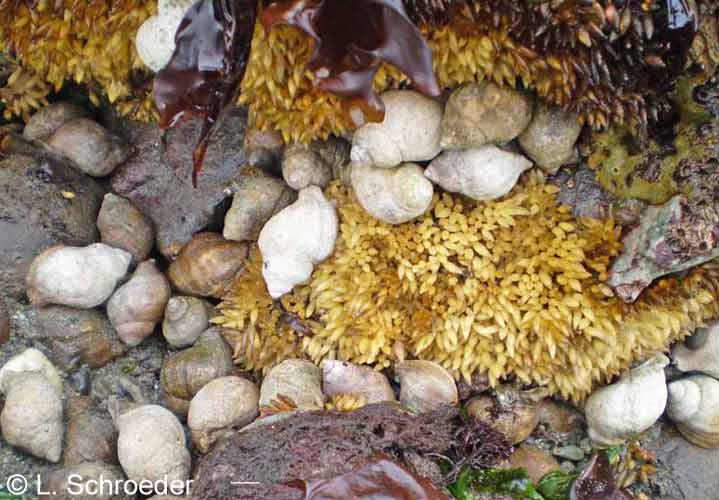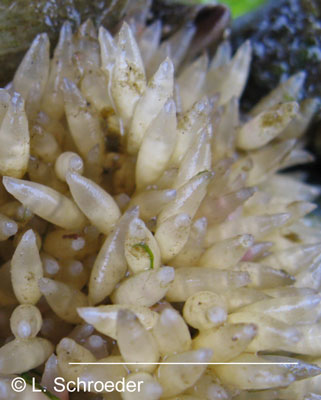Gastropods
Family Cymatiidae & Muricidae
Click on photo to enlarge. Scale line in photo equals 1cm unless otherwise specified.
* Species which are commonly encountered on the beach.
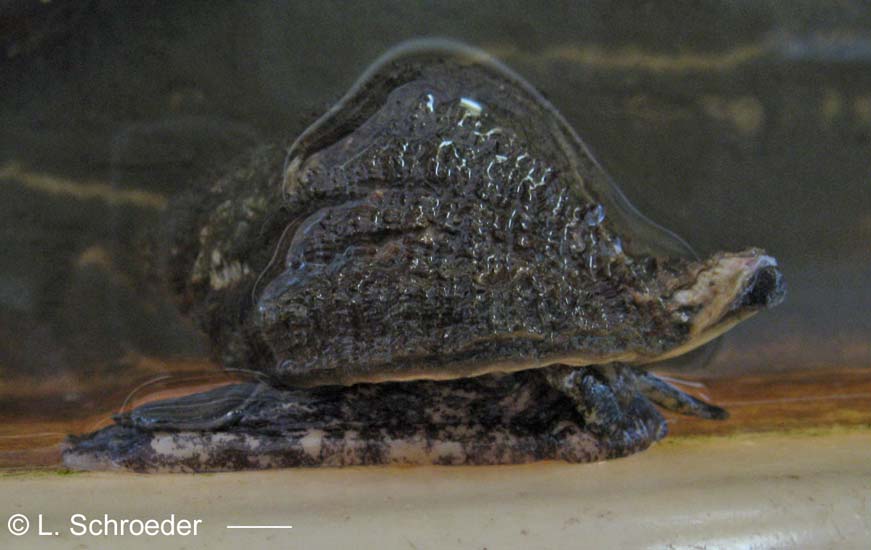
photographed in an aquarium
Muricidae: Subfamily Pagodulinae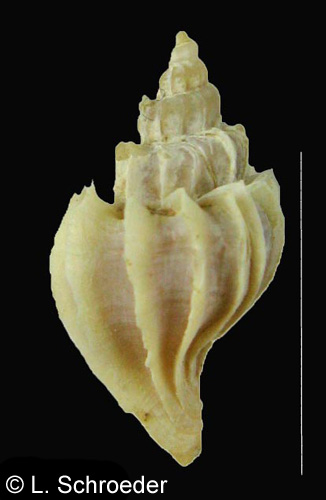
Neah Bay, WA
(Eschscholtz, 1829)Ribbed Trophonintertidal to 15m size to 17mm
southern California to central Alaska
This is occasionally found intertidally, but mostly in Alaska. The shell has sharp-edged ribs which slightly fold over.
(previous name - Trophon multicostatus)
Fusitriton oregonensis (Redfield, 1848)
Oregon Triton
intertidal to 180m size to 15cm
northern Mexico to northern Alaska; Japan
This
is rarely found intertidally. This otherwise white shell has a
thick, hairy periostracum. It lays its distinctive eggs on
vertical rock faces.
This is the state shell of Oregon.
(synonyms - Argobuccinum oregonesis, Argobuccinum pacifica, Argobuccinum coosense, Ranella oregonense, Gyrineum corbiculatum)
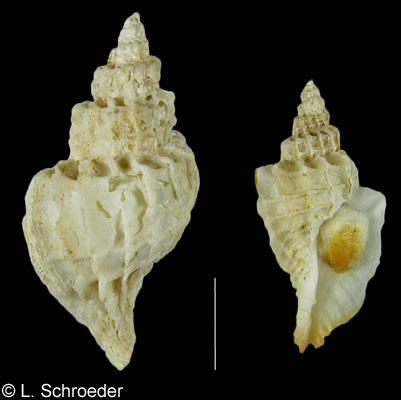
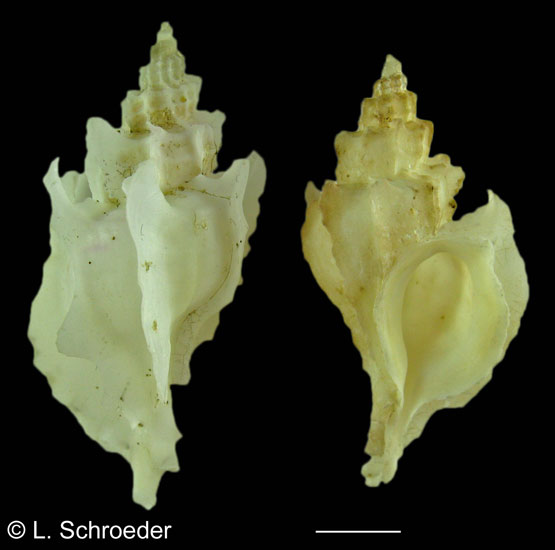
San Juan Islands, WA south end Queen Charlotte Strait, BC
Scabrotrophon stuarti (A.E. Smith, 1880)Winged Trophon
intertidal to 100m size to 60mm
southern California to northern Alaska
This
is rarely found intertidally. A juvenile shell exhibits prominent
crosshatch sculpturing. As the shell grows, the ribs develop
into flared varices. The size of these can vary.
(synonyms - Nipponotrophon stuarti, Boreotrophon stuarti, Trophonopsis stuarti, Trophon stuarti, Boreotrophon smithi)
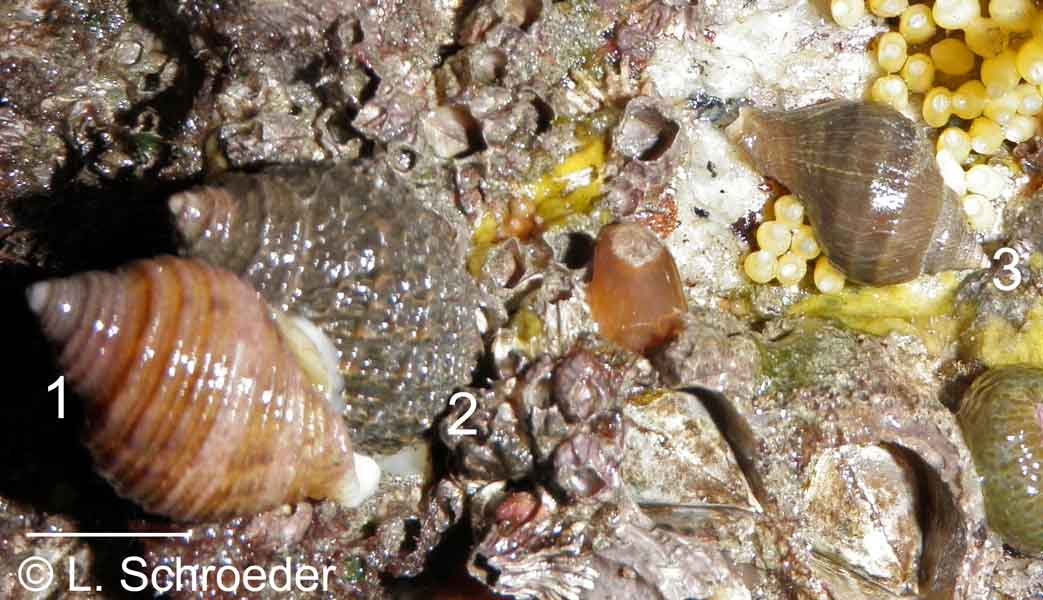
Port Townsend, WA, intertidal
Nucella grouping
1 - young Nucella canaliculata; 2 - adult Nucella ostrina; 3 - young Nucella lamellosa; The eggs in upper right belong to N. ostrina.
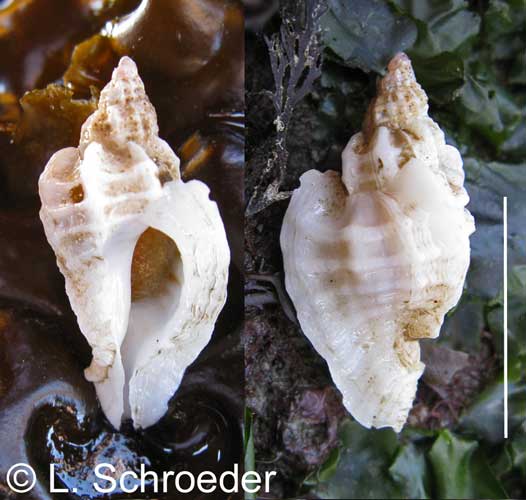
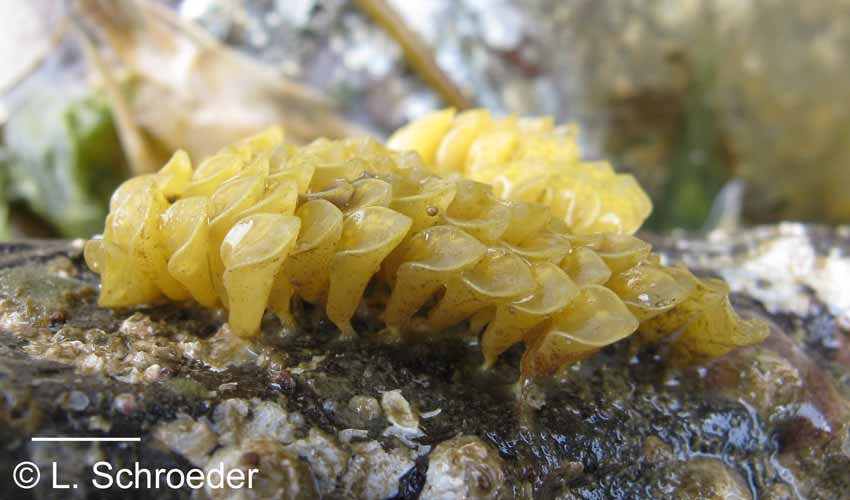
Anacortes, WA, intertidal, juvenile
Pender Island, BC, intertidal, eggs
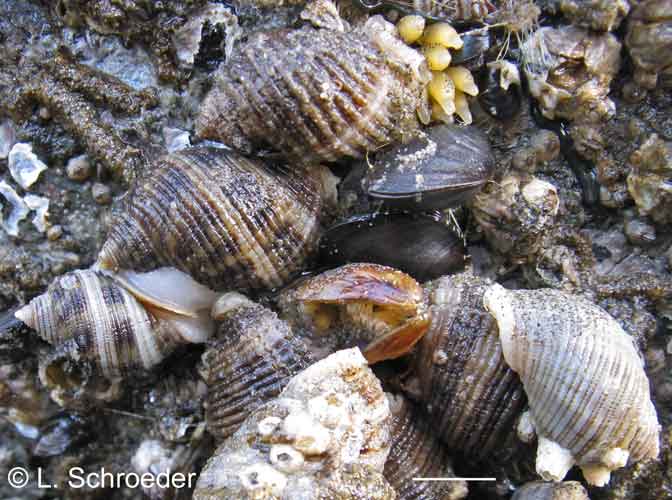
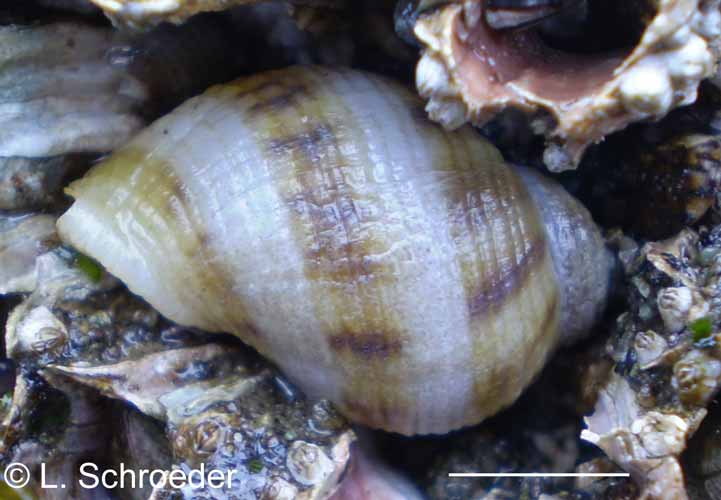
Westport, WA, intertidal
Marrowstone Island, WA, intertidal
Bremerton, WA
Neah Bay, WA, intertidal
Freshwater Bay, WA,
subtidal
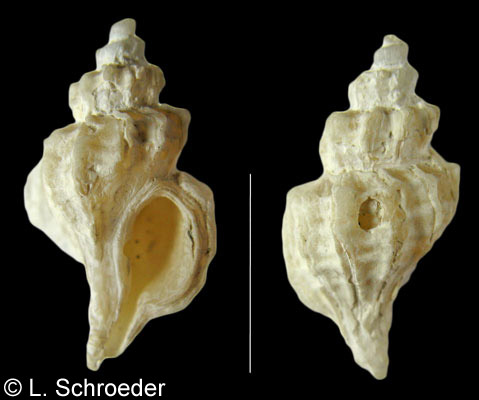 Vancouver, BC
Vancouver, BC
Trophonopsis orpheus (Gould, 1849)Corded Trophon
subtidal to 150m size to 25mm
southern California to central Alaska
This shell has spiral cording and prominent, thick ribs. It also has a long siphonal canal.
(previous names - Boreotrophon orpheus, Trophon orpheus, Ocenebra orpheus)
Nucella canaliculata (Duclos, 1832)
Channeled Dogwinkle *
intertidal to at least 21m
size to 40mm
central California to northern Alaska
This is common to
find. The shell may be a uniform gray-brown or brightly striped
with orange, yellow or white. It has strong spiral cording with
varying degrees of spacing between them.
(previous names - Thais canaliculata, Purpura canaliculata)
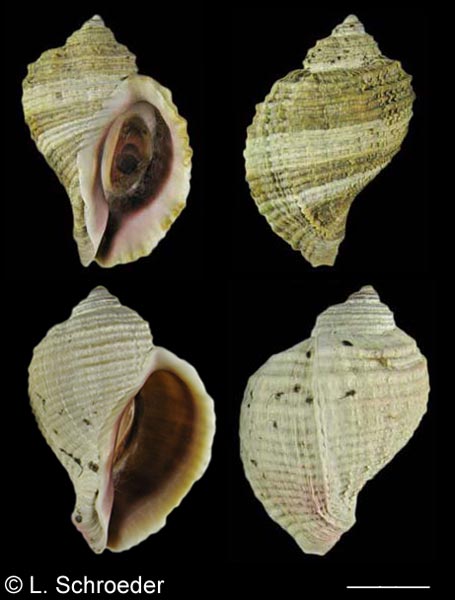
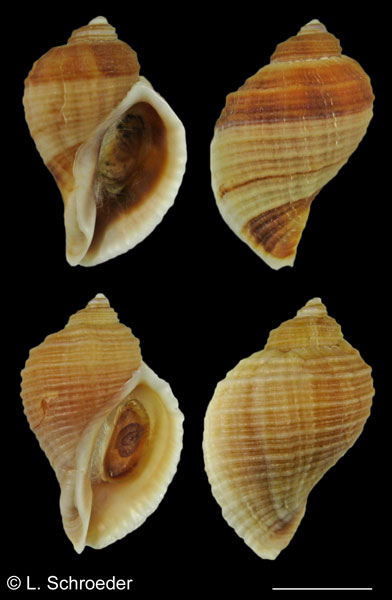
Petersburg, AK
Juneau, AK
Nucella lima (Gmelin, 1791)
intertidal size to at least 35mm
southeast Alaska to Kamchatka Peninsula, Russia
Occasionally found in SE Alaska but more common in the Aleutians. Very similar to N. angustior, but is larger in size with a shorter spire and wider aperture. The low spire comprises less than 25% of the shell's
height. It overlaps in range with the much rarer N. angustior through at least SE Alaska.
(Thank you to Roland Houart for identifying these specimens.)
Nucella lamellosa (Gmelin, 1791)
Frilled Dogwinkle *
intertidal to 10m southern California to northern Alaska size to 125mm
This
species
is very common. It is highly variable in
color, shape and sculpturing. These factors vary with
habitat. The shells may be smooth to highly frilled, drab
and gray
to white, orange, purple or brightly striped. Where rock crabs
are evident, the shells become thick and heavy to avoid being eaten by
the crabs. In some areas their spires are very elongated. Large
clusters of their eggs are often seen in spring and early summer.
(synonyms - Thais lamellosa, Thais lamellosa cymica, Thais lamellosa hormica, Thais lamellosa franciscana, Thais lamellosa neptunea, Thais lamellosa sitkana, Buccinum lamellosa, Purpura crispata)
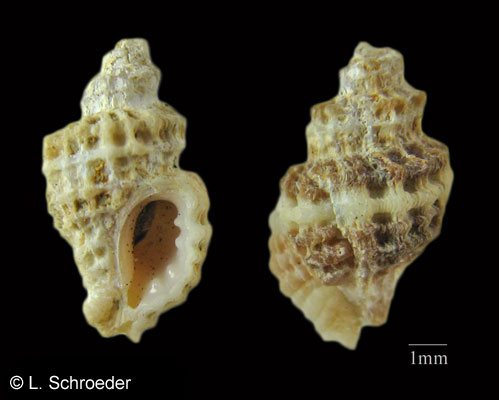 Makah Bay, WA
Makah Bay, WA
Paciocinebrina atropurpurea (Carpenter, 1865)Purple Rocksnail
intertidal to 30m size to 12mm
northern Mexico to northern BC
This
is rarely seen intertidally in our area. The shell has prominent
crosshatch sculpturing. The color may be white to purplish-brown.
(previous name - Ocinebrina atropurpurea, Ocenebra atropurpurea)
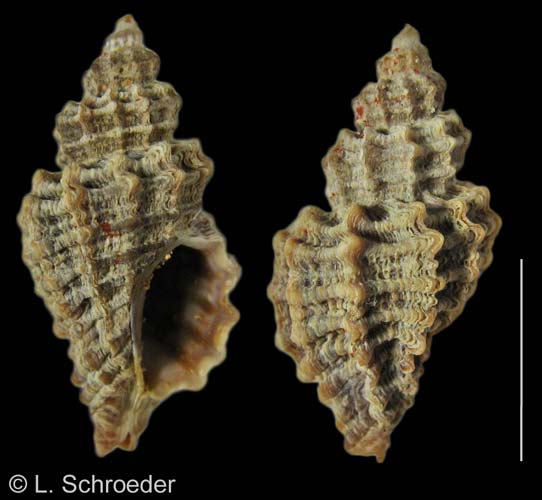
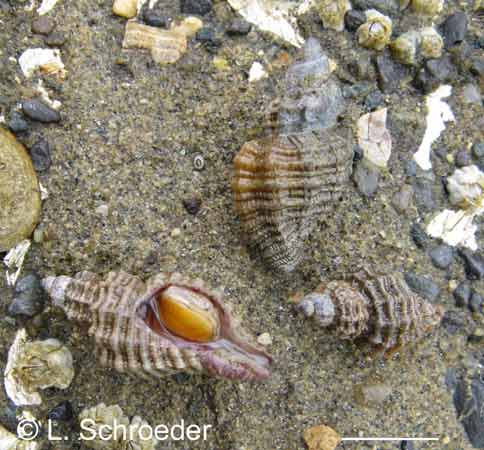
Port Hardy, BC
Sooke, BC, intertidal
Paciocinebrina interfossa (Carpenter, 1864)
Sculptured Rocksnail *intertidal to 100m size to 25mm
northern Mexico to Alaska
This
is commonly found intertidally. The shell sculpture is somewhat
variable, from prominent to somewhat muted. The color may be
light brown to dark purplish-brown. The inside of the aperture is
usually dark.
(synonyms - Ocinebrina interfossa, Ocenebra interfossa, Tritonalia interfossa, Ocenebra clathrata, Ocenebra fraseri)
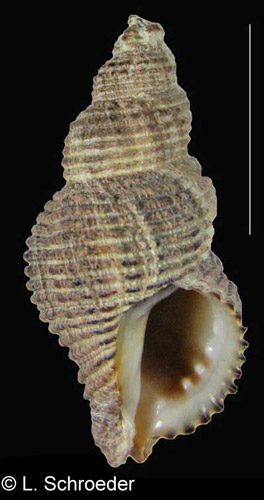
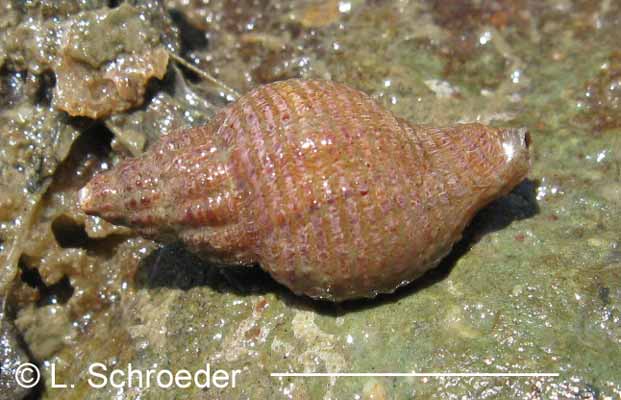
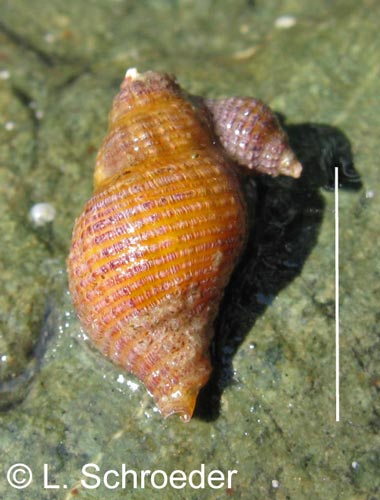
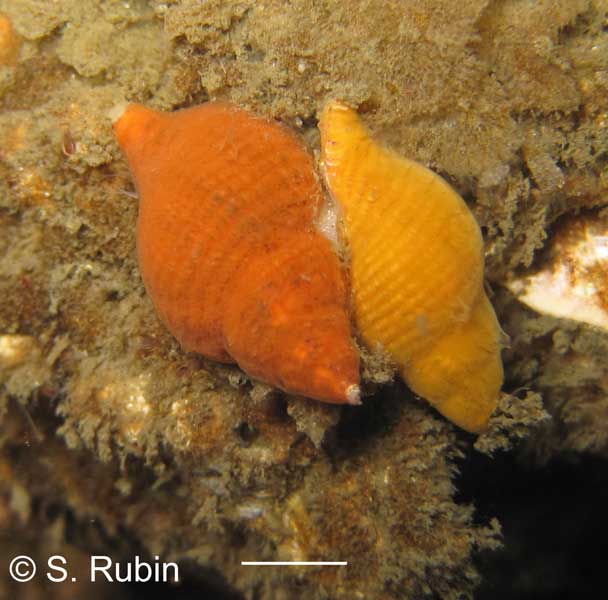
Whiskey
Creek Beach, WA Anacortes, WA, intertidal
Anacortes, WA, intertidal
Freshwater Bay, WA, subtidal
Paciocinebrina lurida (Middendorff, 1849)
Lurid Rocksnail *intertidal
to 200m northern Mexico to central
Alaska size to 40mm
This is fairly common. The color ranges from yellow to orange to brown. The shell exhibits even spiral cords.
It also has widely spaced vertical ribbing which is highly variable from almost
absent to very distinct. Usually the vertical ribs are evident on at
least the early whorls.
(synonyms - Ocinebrina lurida, Ocenebra lurida, Urosalpinx lurida, Tritonalia lurida, Tritonium luridum, Ocenebra rotunda)
Nucella ostrina (Gould, 1852)
Northern Striped Dogwinkle *
intertidal
northern California to northern
Alaska size to 40mm
This species is very
common. The shell is highly variable. It typically
has a short spire and tall aperture compared to the height of the
shell and the spire height can vary. The shell usually has spiral
ribs which may or may not be pronounced, but it may also be smooth. In some areas, the shell
also exhibits "frills" on the ribs. Color varies from solid to
striped, and may be white to orange to brown to black. Its eggs
are short and stubby compared to those of the other Nucellas. This
species was separated from Nucella emarginata, which is now known to be a southern species. Where the ranges overlap in northern California and southern Oregon, it
is extremely difficult to tell the shells apart.
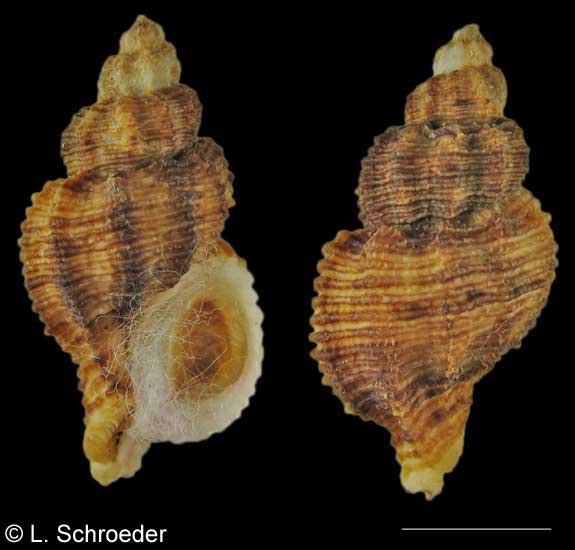 Neah Bay, WA
Neah Bay, WA
Tunstal Bay, BC
Scabrotrophon maltzani (Kobelt & Kuster, 1878)
intertidal to 1000m size to 50mm
northern Mexico to northern Alaska
This
is rarely found intertidally. The shell has spiral cords and
axial ridges with a tall spire and a very long aperture, which give it
an overall slender appearance.
(synonyms - Trophon maltzani, Nipponotrophon maltzani,Trophonopsis lasius, Trophonopsis tenuisculptus, Trophon subserratus)
This page last revised: 6-15-2024
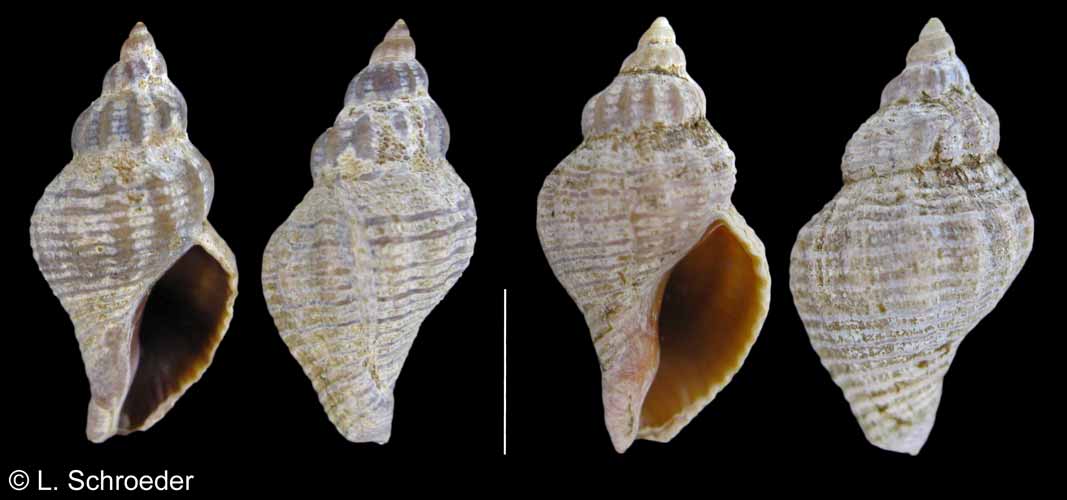
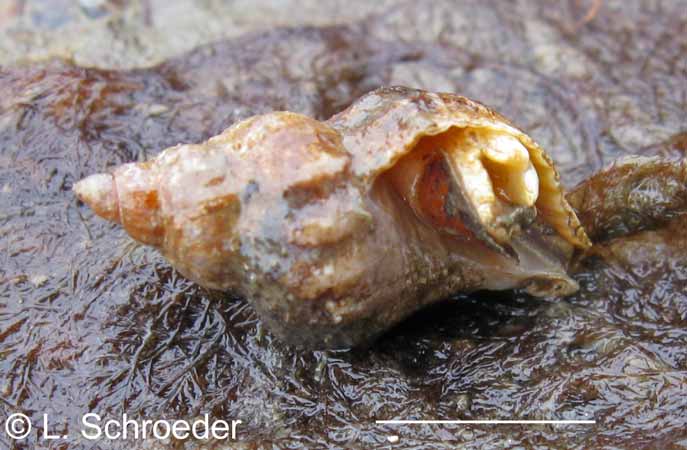
all photos of shells and eggs from Willapa Bay, WA, intertidal
Paciocinebrina sclera (Dall, 1919)
Sclera Rocksnail
very low intertidal to subtidal size to at least 42.6mm
central California to northern BC
This
is very rarely seen intertidally and then only on an exceptional low
tide on the outer coast. The shell has even spiral cords and
widely spaced vertical cords. The color may be orange to brown.
It is similar in appearance to O. lurida, but has a wider body whorl and deeper suture lines.
(previous name - Ocinebrina sclera, Ocenebra sclera, Urosalpinx sclera)
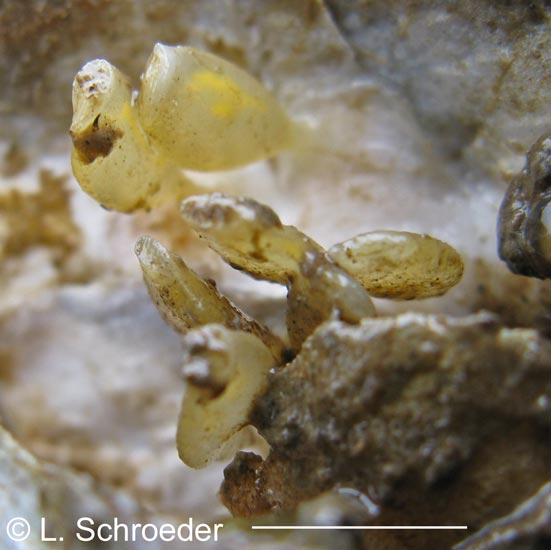 egg cases
egg cases
Urosalpinx cinerea Say, 1822
Atlantic Oyster Drill
intertidal to 15m size to 43mm
northern Florida to southeast Canada; introduced to west coast
from central California to southern BC in oyster beds
It can be common where introduced, near commercial oyster production in river estuaries.
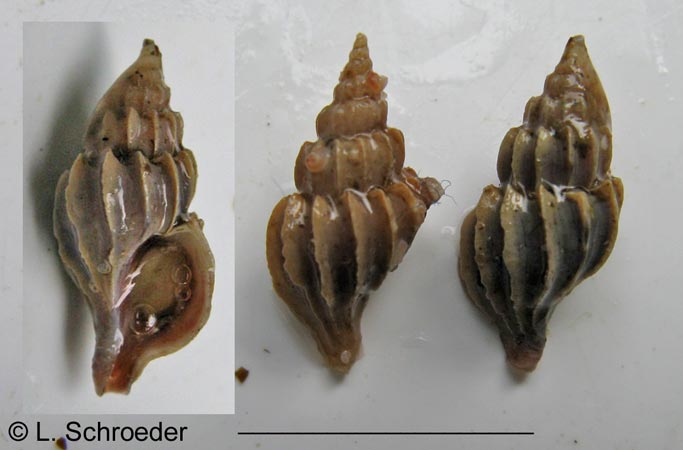 Port Hardy, BC, intertidal
Port Hardy, BC, intertidal
Boreotrophon vancouverensis Houart, Vermeij & Wiedrick, 2019
intertidal to 37m central BC to south Alaska size to 16.6 mm
Infrequently found, but not uncommon at its known sites. Smaller than most Boreotrophon.
Ceratostoma foliatum (Gmelin, 1791)
Leafy Hornmouth *
intertidal to 65m size to 10cm
southern California to central Alaska
This
is fairly common to find intertidally. The juveniles exhibit
crosshatch sculpturing. The axial ribs grow to large flares as it
matures. The adults may be plain white to purplish and may be
striped. At the base of the aperture there is a projecting tooth.
It lays a distinctive egg case.
(previous names - Pterorytis foliatus, Purpura foliatum, Murex foliatum)




